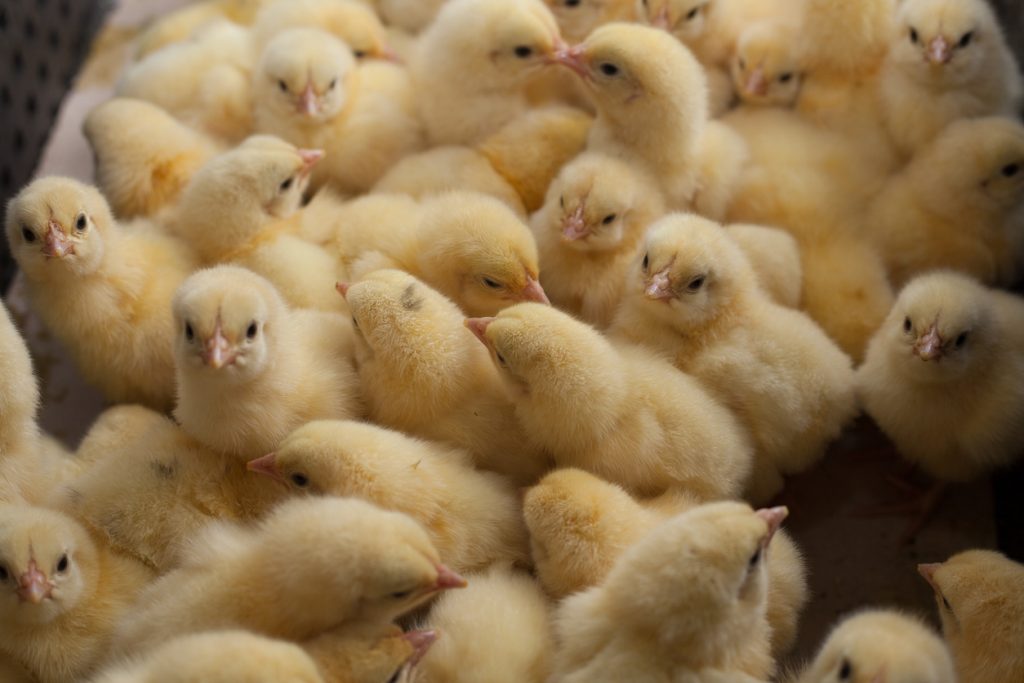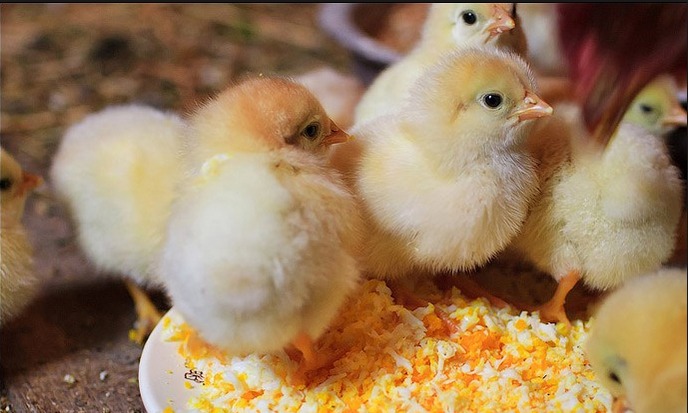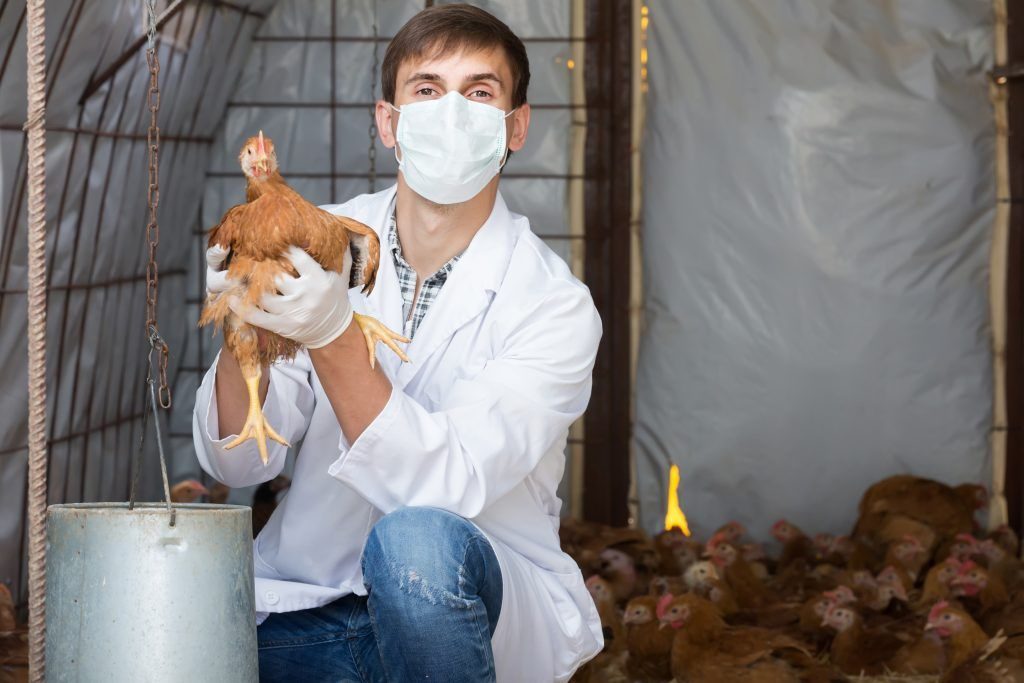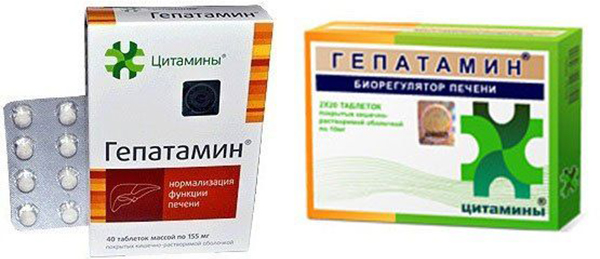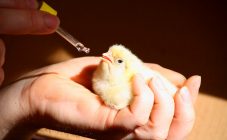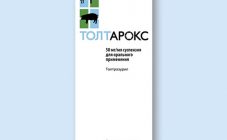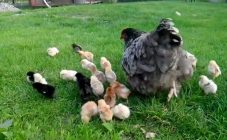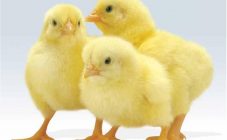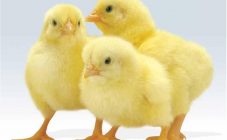Under natural conditions, the brooding hen takes care of the chicks after hatching. After incubation of eggs, care for the offspring falls on the shoulders of the poultry farmer.
Chick care rules
Once hatching chicks have hatched, they should be transplanted into a separate room.
The main requirements for it are as follows:
- Cleanliness is one of the most important conditions. Cleaning should be done daily to avoid the development of pathogenic microorganisms.
- Litter. Must be well dried and clean. It must be replaced regularly. You can use paper as a bedding.
- Ventilation. Air stagnation should not be allowed, this will lead to a change in humidity and have a detrimental effect on the health of the young.
- Square size. When keeping a large number of chicks in an insufficient area, a weakening of the musculoskeletal system may appear.
- Lighting. Day length is one of the most important factors in chick development. During the first days of life, the light should burn for 18-20 hours. With age, this lighting period can be shortened and left at 10 hours by 4 months of age.
- Temperature conditions. Temperature changes depend on the age of the birds being raised. For day old chicks, 32 ° C is required. In the period from day 6 to day 20, it is necessary to gradually reduce the temperature to a level of 25 ° C. From one month of age, daily fluctuations can be in the range of 20-24 ° C. As sources of heat, you can use: heating pads, bottles filled with warm water, incandescent lamps, reflectors fixed in a place inaccessible to the chicken.
After hatching, wait until the chicks are completely dry before feeding. You can use a flat surface as a feeder by sprinkling corn grits into it. It has a small size and is ideal for training chicks to feed. Daily chickens can add wheat, barley and semolina, millet, chopped oat flakes to corn grits.
Dispense food at intervals of 2 hours in small portions. Why split cereals into separate meals? When mixing cereals, chicks can selectively peck out the one they like best, so it is better to give out one type of food at a time.
For growing chickens, it is useful to diversify the diet with cottage cheese. Calcium contained in the composition will avoid problems with the formation of the chicken skeleton. You can add cottage cheese to the diet already from 2-3 days, having previously mixed it with cereals. Also, instead of water, you can fill the drinker with kefir or whey. From the third day, you can start feeding the chickens with green food. It has a beneficial effect on bowel function. Nettle, clover, plantain and dandelion are suitable for this.
From a monthly period, you can release chickens for walking in the yard. The basis of the diet at this time is made up of fresh herbs. Herbs provide the necessary amount of vitamins and minerals necessary for the good health of the chicks. You can also start introducing coarse feed, and leave whole grains from a month and a half.
Cloacite in chickens: symptoms and treatment
Why does the cloaca stick in chickens? The reasons leading to the disease can be prolonged constipation, inflammation of the oviduct or a violation of the egg-laying processes, and therefore the cloaca can crawl out.
Since the cloaca is involved in egg production, the bulk of the affected birds are layers. However, the disease can also appear in broiler breeds. If the intestines of a broiler chicken come out of the anus, you should immediately contact your veterinarian.
The most common cause of cloacite development is an unbalanced diet. Deficiencies in vitamins A and E can lead to cloaca shedding in broiler chicks. The diet should be carefully monitored, focusing on the age, health and activity of the individuals. When the cloaca sticks, the bird will try to lick the anus to relieve pain.
Constipation can also be caused by poor diet. With the first signs of changes in stool and its frequency, one should suspect the possible development of cloacite. In chickens, the structure of the oviduct begins to change, the glands can become inflamed, and instead of laying the egg, it can stick to the walls, from where it is ejected back into the abdominal cavity.
Disease prevention tips
As a preventive measure, you should regularly monitor the behavior of each chicken. Any changes associated with appetite, changes in the stool of individuals should be immediately brought to the attention of a specialist. In addition, contamination of feathers under the tail or feather loss can be a symptom of the disease. What to do if chickens have a dirty cloaca? When the cloaca falls out, dirt may adhere to the damaged area. It is necessary to cleanse the cloaca from suppuration, lubricate with 5% iodine solution and any bactericidal ointment.
To maintain the liver, drugs containing methionine, lysine, or a complex drug hepatomin can be administered. These components will help to activate the metabolism in the liver.
If the chicken has a dirty cloaca, what to do first? If constipation is found under contamination, you can eliminate it yourself by manually cleaning the cloaca and rectum from feces. To do this, you should treat the unwashed anus with fresh warm urine, and after the procedure, lubricate the damaged area with an aqueous solution of mummy. What to do if a chicken's intestines come out? It is necessary to rinse it thoroughly, lubricate it with levomekol ointment and carefully set it in place. Thereafter, until the injury heals, a few drops of Vaseline oil should be given daily to facilitate the bowel movement.
At the onset of the disease, after the dosage is prescribed by the veterinarian, feed antibiotic drugs (bioschrot, flavomycin) are used to prevent the development of intestinal infections, or antibacterial toxin-binding substances.
Summing up, we can say that compliance with the conditions of detention and care will prevent the appearance of cloacite. Timely medical assistance will save all livestock from death.
